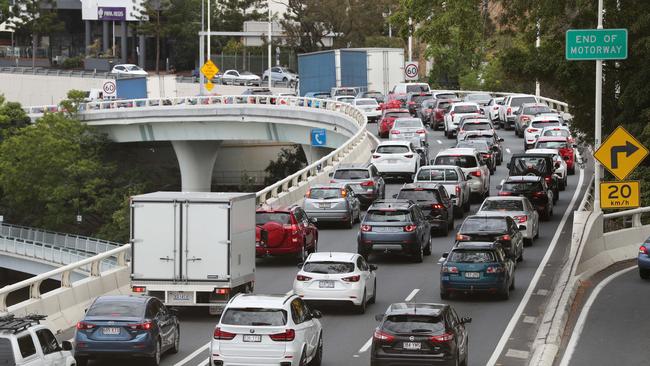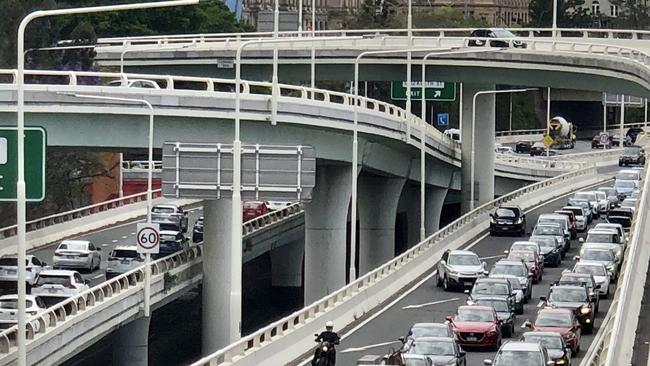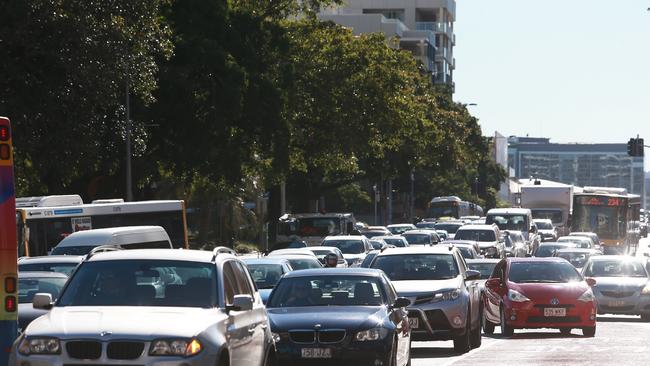Perfect storm of construction projects to trigger CBD delays
Travel times are expected to balloon for drivers and public transport commuters alike, with construction projects closing roads and forcing more cars onto CBD streets.
QLD News
Don't miss out on the headlines from QLD News. Followed categories will be added to My News.
Travel times are expected to balloon for drivers and public transport commuters alike, as a perfect storm of construction projects closes roads and forces more cars onto CBD corridors.
Brisbane City Council modelling suggests CBD travel times could soar above and beyond pre-COVID levels, as major construction projects such as the Brisbane Metro, Cross River Rail, Queens Wharf and the CityLink Cycleway proceed in 2021.

Travel times through the CBD are expected to increase by almost four minutes along Edward Street alone, while Council also expects “extended queues on the Riverside Expressway, including on the Captain Cook Bridge and to Coronation”.
Public transport commuters may also experience delays to bus services into and within the CBD, according to modelling – as road closures and construction projects push more vehicles onto inner-city streets.
Council expects delays to impact Mary, Charlotte, Edward and Elizabeth streets increasing traffic to beyond pre-COVID afternoon peak times as Victoria Bridge closures converge with work on the City Link Cycleway and Brisbane metro.

Ongoing weekly meetings will be held to monitor and to minimise impacts of commuters – however early indicators suggest delays of around 200 seconds to be tacked onto Edward St trips for the 900m between Turbot St and Alice St.
Council predicts choke points will continue to change, expecting “substantial redistribution of traffic will occur within the CBD as motorists change their travel patterns/routes to avoid key congestion points”.
Currently council modelling shows traffic volumes on certain city streets – including Ann, George, Elizabeth and Edward streets – are less than late last year.
However, afternoon peak hour travel along Roma St takes longer now than it did before the coronavirus pandemic, following the closure of Victoria Bridge which council predicted would spark delays of up to 20 minutes as up to 10,000 cars are diverted each day.
Council claimed “70 per cent” of affected cars would be diverted along the William Jolly Bridge – equating to a traffic increase of about 14 per cent.

It comes as a new RACQ report showed Brisbane’s arterials are more congested now than before the pandemic, with congestion levels reaching 90 per cent and commuters shunning public transport for cars.
“This data proves what many of us have been thinking, traffic in Brisbane is getting worse,” RACQ spokeswoman Lauren Ritchie said.
“Average congestion back in 2019, pre-COVID-19, was peaking around 49 per cent,” Ms Ritchie said.
She said there were roughly 423 traffic jams across Brisbane just last week, as school returned.
Lord Mayor Adrian Schrinner said congestion was “the talk of Brisbane at the moment” and that delays and traffic volumes across Brisbane were a “timely reminder … that public transport is good for Brisbane”.
“As we have, from next month, the vaccine starting to roll out … we now have an opportunity for a higher level of confidence to come back to our public transport,” he said.
“Every person extra that gets on public transport is good not only for the people using the system but for the people who aren’t using it.”
Council will be continually exploring strategies to “reduce the need for private vehicle travel within the inner city”, as progression of construction projects continues.
.


